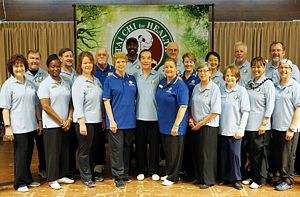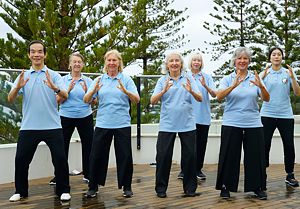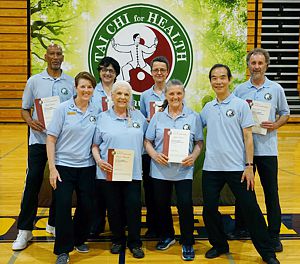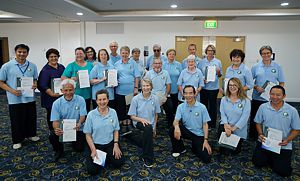Adaptations and Guide To Master Trainers To Conduct Instructor Training Workshop Via Zoom
This document has been approved by the Tai Chi for Health Institute board and is the result of joined effort by: Dr Raymond Lau, Nuala Perrin, Pat Lawson, Rani Hughes, Dr Janet Cromb, Fiona Black, Betty Scanlon, and Ileina Ferrier, and Dr Paul Lam

August 13, 2020
Our goal is to train safe, effective Tai Chi for Health instructors. Now we have the additional immediate goal of maintaining momentum in a virtual environment without compromising the integrity of the programs.
In summary: Both the curriculum of training and the requirements of certification remain unchanged. To ensure that the interactive and haptic competencies (previously assessed in an in-person environment) are met in the virtual environment, private Zoom sessions with the Master Trainer are required for each participant. More details are below. It is recommended that MT’s, when possible, consider mentoring with an experienced MT prior to hosting their first virtual instructor training workshop.

Important points are:
- Participants will complete the modules on the history of tai chi, features of the program, the condition and how tai chi works, teaching safely, effectively, understand tai chi principles and able to perform the specific program as required. Modifications of the lesson plan for remote learning, as attached, should be followed.
- The platform for remote teaching must be Zoom, with the meeting mode; there is constant interaction between MT and participants. Webinar mode will not work. Our requirements for instructors are based on adequate prior preparation and appropriate professional experience in equivalent of 200 hours. The workshop training focuses on stimulating thinking, sharing experience and tai chi energy. Webinar mode is lecturing, most of our skill and knowledge required cannot be learned by listening to lectures.
- For the first time offering a virtual certification, the MT must limit enrolment to 10 or fewer participants. With experience the number is at the MT’s discretion, but not to exceed our prior limit of 25. Keep in mind that the MT’s monitor must be large enough to allow observation of all participants simultaneously. For the SPTM Role Play exercise and for brainstorming, the MT should use the meeting rooms with ST support. If there is a strong demand for accepting another platform, please let Dr Lam know and the board will form a committee to investigate.
- Ensure your participants are familiar with Zoom at least at basic level, otherwise you would spend hours sorting that out during the workshop. Some MTs have STs help out by them talking to participants who are not web savvy. Your advanced students or web savvy friends might be recruited to help monitor chats. One suggestion is to have a Tech Check” session with an ST prior to the start of the workshop.
- Watching a screen can be more tiring, without physical feedback and group energy remote teaching can be quite challenging. That is why the online lessons are helpful. Just imagine we are co-teaching. While I teach the movements, you can sit back and have a quiet time working on giving participants feedback and encouragement.
- Even though it was a requirement for our participants to learn the movement through Dr Lam’s online lessons or instructional DVD, as well as studying the Teaching Tai Chi Effectively book, with remote learning it is even more important that participants have been well prepared. For this reason, they must, prior to the workshop, submit a video of themselves demonstrating adequate, safe execution of the movements to the MT. It is not a test, nor is perfection expected. It is meant to motivate the participant to learn the basic shape of the movements prior to the workshop, which helps ensure success.
- The training should have at 14 hours of teaching as the lesson plan. It is ok to have more if needed and can be divided in different sections, for example four morning sections rather than two days. Be sure to give breaks, a good way is to have a few days or more sessions through a 14+ hour training.
- The test is still required but please do not email it. The Poll feature could be used, or the white screen posting the questions while participants record on a document to email to the MT.
- The individual participatory zoom sessions with the MT are required of each participant who requires certification. This portion will include learning activities on Stepwise Progressive Teaching Method and Safety as well as forms performance. As always, the MT must be very careful to observe and ensure that the participants have met the standards and exhibit a caring attitude.
- The individual zoom sessions are recommended to be an hour, more if needed, for each participant. The first one can be scheduled at the MT’s discretion during or after the workshop. The second session must be completed between 3 to 30 days after the first private session. The MT will work on forms review, set up the SPTM role play exercise with the MT as “student and observer” and check understanding of the knowledge points with each participant privately. To ensure good understanding of teaching safely, the MT should ask questions such as what the three most important ways are to stay safe, listen and discuss. Only through listening and discussion can MT be confident that the participant will be teaching safely, not by giving a quick lecture.
- IF a participant has prior Tai Chi for Health certifications and is very adept and knowledgeable, the MT may, at his/her discretion, shorten the private session but never reducing it to less than 40 minutes. That is, competent participants will have at least 40 minutes on one private Zoom sessions with the MT. First time participants must have at least two sessions of at least 40 minutes each.
- Very importantly, our training is personal; with remote teaching we need to make more effort to be personal! Teach confidently and try to create a comfortable ambience. This would not be possible unless you are proficient with Zoom, and participants are familiar with it. Perhaps add a short personal story, and gentle humor to get people comfortable.

Notes for Success for All:
- Fee should be the same as normal workshops but be lenient to people in difficulty, do not lower the price but offer part or full scholarship. There should not be price cutting or competing.
- Observe common courtesy, avoid teaching people far away from you. You can refer participants to your colleagues. Certainly, avoid cross different country, unless there is a compelling reason. We work with each other as a family, not in competition. This does not mean you cannot do this, but you should observe courtesy by offering participants the MT closer to them first. Unless the participant/s has valid reason to your workshop. If so keep a record of the reason/s.
- As always, the MT makes the final judgement on whether a participant has met the standard and fulfilled all the requirements and bears that responsibility. The MT may require more than the minimums set forth in this document. For example, at the MT’s discretion the hours may be increased—but not decreased.
- Good setting and presentation are essential on using Zoom. The MT must learn and practice this platform well before using it to conduct workshop. Consider using appropriate courses and learn from Zoom, or a teacher.
- Lighting needs to be adequate, space adequate (including your participants who must have adequate space to show you), sound checked, you might need an assistant present for the camera.
- Dr Lam strongly recommends teaching collaboratively with his online course, using the share screen. Think of a model as though you are co-teaching with Dr Lam, he teaches the movements, you focus on observing, feedback, guiding, encouraging, pointing what was done well and what can be improved. See the guide on our website https://taichiforhealthinstitute.org/guide-to-conducting-lessons-via-internet-for-board-certified-instructors-with-dr-lams-online-lessons/

The world is changing, and we need to adapt appropriately. Let Dr Lam know if there is any concern or point of improvement. We can work together for the benefits of all to further our vision. We can continue to train safe, effective tai chi exercise instructors with these careful adaptations.
These measures are relating to the challenging time, we will learn a lot from it and we can use the new knowledge to improve our work in future, pending on the outcome these adaptations could be changed.
A good thing is most of the principles of adaptations here can apply to instructors. By using this method well, you are also teaching your participants how to teach the program to their participants remotely. Currently, more and more people need tai chi to improve immunity and health, as well as relieve stress. This is our opportunity to help more people!
